The Big Time is Where You're At:
Questions for Vanessa Renwick
By Deborah Stratman
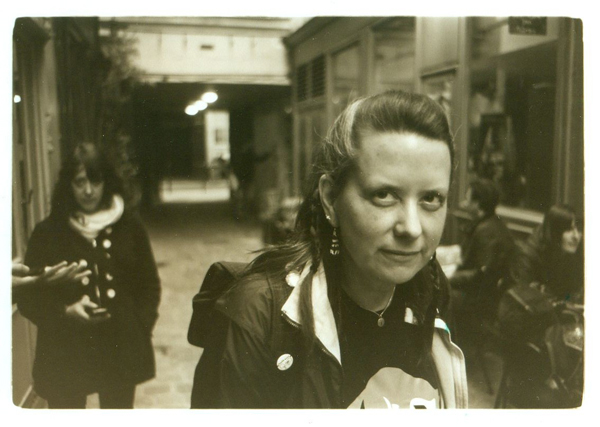 Vanessa Renwick / Photo: Lisa Schonberg
Vanessa Renwick / Photo: Lisa Schonberg
A lady surrealist painter who I don’t know much about named Mimi Parent is responsible for one of my all time favorite quotes. She said, KNOCK HARD. LIFE IS DEAF. It’s a maxim that the filmmaking, sauna-building, dog-wrangling, hard-traveling, child-rearing Daughter of the Revolution Vanessa Renwick aptly personifies. Here are some questions I had for her, and the answers she thoughtfully gave:
Deborah Stratman: Who is Bob Landis and how do you know him?
Vanessa Renwick: Bob Landis lives in Gardiner, Montana. He is a cinematographer and collector of sound and images of wildlife. He also has made a few National Geographic films. I met him at a Wolf Conference in Chico, Montana. For a few years, every spring, there was a conference, and all the wolf biologists and some ranchers would show up to this old resort with a hot spring swimming pool and do three days of PowerPoints of what they learned that year. At night they would retire to the bar, start drinking and howling. I attended for four or five years. One of the highlights every year was seeing footage that Bob shot at the end of the conference. I also shared my new work with them. So, they got to see what I was about.
I first asked Bob for some audio of ravens for 9 is a secret (2002). He sent me a DAT tape with noted timecode. I listened and listened, fast forwarding and rewinding around the timecode spot and could not deduce raven noises. It sounded like I was listening to someone take a shit in a toilet. I thought he was playing a joke on me. Turns out he gave me the wrong timecode for the raven noises on the tape. That timecode was for noises of otters in the river. The best raven noises were elsewhere on the tape. He had told me I could use his images as long as they were not on TV. No problem, right! The next time I asked him if I could use some wolf footage, and that they would be looping on monitors inside refrigerators, not on TV. So that's how I started using his footage. OH MY GOD. His footage is so amazing. He is out there before anyone else shooting. You will see him coming back when you're just entering the park. I like that I can let his long shots play out in my work. In the films that have been made with his footage, I don't think one ever sees the really long takes which are just breathtaking. When I watch his footage, I always appreciate him freezing his ass off at dawn shooting it. He is at one with the movement of the animals. A stellar cinematographer and person!
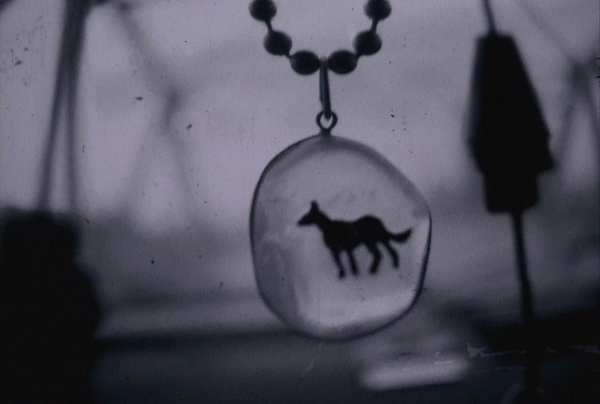 SF Hitch / Vanessa Renwick
SF Hitch / Vanessa Renwick
DS: In one of your earlier films, SF Hitch (1981/2012) you say “I didn’t care where I was going as long as I was going,” which made me laugh because in one of my early videos, shot on a train from Chicago to L.A., I stuck little vinyl letters onto the window by my seat and filmed them. It was a Robert Louis Stevenson quote: “I travel not to go anywhere but to go. I travel for travel’s sake. The great affair is to move.” Can you talk about filmmaking and its connection to restlessness?
VR: Actually, that film was just made in 2012. A lot of the footage was shot in the early-80s, and some in 2005 and 2007, but I just told the story this past year. The first bio I wrote for a screening I was in said that I was a gypsy stolen from my family and turned to filmmaking to make up for lost travel time. Making films puts me in so many situations I never would be in otherwise, and through the making, I learn so much more. So, it is like traveling, even if it is right in your hometown. You're being exposed to the innards of something that fascinates you for some reason, pulling you in and onward. You're seeing things in a new way. New landscapes. It is almost similar to hitchhiking, where you end up being with people that you wouldn't normally be with, stretching yourself out there.
DS: What is the furthest you've been (or felt) from civilization?
VR: Hmmmmm. Funny, but it was right inside Chicago. When I was a kid I would go to Montrose Beach with my dog, or my neighbor's dogs before I was allowed to have my own. Walking dogs was my entrance to being able to venture out into Chicago all by myself. The beach was not far from my house, about a mile or two from where I lived in Uptown. In the winter, when there was six feet of snow and upward, I would bundle up and head into the park towards the beach. It was like a whiteout right within the city. No one else was ever out there, or maybe one person I would see dimly appearing momentarily through the blizzard. I would walk to the end of the beach, out on to the curly cued breakwater, if I could, if it wasn't too icy. It was the best ever. Snow so deep, me all pumped up from trudging through the high stuff, wind whipping all around me, cheeks so red and frozen, some steadfast dog with me, and no one at all in sight. The beautiful flat nothingness of Lake Michigan all in front of me forever and ever. No light pollution that way, or at least what I believed to be was darkness at that time. I hadn't experienced real darkness at that time in my life yet. I have definitely been way farther away from civilization a few times in my life, but somehow that time, growing up right inside Chicago—my first glimpse of what appeared to be the wide openness of nothingness all by my lonesome, with dog, is the most memorable. I could easily have been in the Arctic. And it felt so amazing to be so alone in the wilds of the elements. The city vanished.

Charismatic Megafauna / Vanessa Renwick
DS: Can you talk a bit about the Renwick wolf-bear-dog-raven-crow-horse animal pantheon? Whether as parables or companions or omens or protagonists... they’re often hovering.
VR: I've always been open to receiving communications from animals, as most of us are, I think, as children. I also used to pretend I was a dog, crawling under the dinner table after eating, and looking at everyone’s knees and shoes and laps, listening to conversations. I couldn't have a dog until I was about 12, but every fiber of me was speaking dog. All my reports in school were somehow about dogs. A teacher called my folks in and told them they either had to get me a dog or take me to a psychiatrist. I knew those creatures were my siblings. And they in turn brought me to wolves, which brought me to the rest of those animals. I am constantly aware of the crows in Portland, and I heard a raven for the first time in Portland this very week, in the forest, early. I rarely ever have walked alone in my life, and when I do, it is so different from being shown things through the dogs’ attentions. My wolf dog Zeb, who I lived with in Chicago, and hitchhiked with, probably showed me the most so far, forcing me to leave my apartment, as he did not want to live in it: ripping up wall to wall carpeting, eating moulding, peeling wallpaper off the walls. He wanted out and got me out into the world. The dog I live with now, Foxy Humper, is the most sensitive dog I have lived with yet, so he is showing me different things. The corvid connection really came on strong after I took my middle name, my grandmother's maiden name, as my last, Renwick, which means, “from where the ravens roost.” I did not know its meaning at the time, but it brought me into a clan I had been missing from.
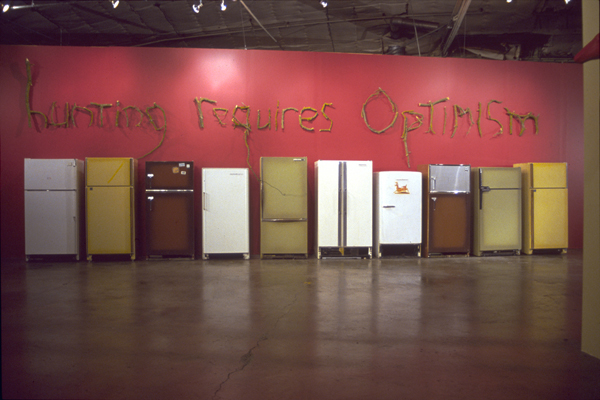 Installation view of Hunting Requires Optimism (Vanessa Renwick) / Photo: Bill Daniel
Installation view of Hunting Requires Optimism (Vanessa Renwick) / Photo: Bill Daniel
DS: I want to talk about hunting. Do you hunt yourself?
I’ve had a firearms license. Maybe it’s still valid. I learned to shoot because an ex of mine kept handguns, and I didn’t want them to be in the house if I didn’t know now to use them. But to me having a gun has always seemed like carrying around a portable black hole, with it’s terminal potential for violence, just mutely there under somebody’s clothing. Archery is more my speed. I like that the force involved is a product of the bow tension and arm strength. We also keep a ten-pump BB rifle, which is very fun for target shooting. It’s nice when the force has to come from your own energy expenditure. It feels more fair, in terms of universal quid pro quo.
At any rate, I’ve never really hunted, except for fishing. Watching Hunting Requires Optimism (2003) made me think about how disconnected most of us have become from death and eating.
 Installation detail of Hunting Requires Optimism (Vanessa Renwick) / Photo: Bill Daniel
Installation detail of Hunting Requires Optimism (Vanessa Renwick) / Photo: Bill Daniel
VR: Exactly! I love the immobility of the people standing in front of the fridges while they are watching these insane chases played out on TV’s inside the fridges, between wolves and prey, nine times out of ten ending up in failure. I have not hunted. I remember sneaking out of some relatives’ window in upstate New York when I was 18 in the middle of the night to meet up with a hunter/hunting guide I had met. We would head off into the forest to fuck. He saw so much cut sign that I did not. I was blind. Well, I have fished a pathetic amount, and went clam digging once, which probably was close to hunting in a way. I've hunted for mushrooms. I just made plans with two friends here to learn archery. Something I've always wanted to do, having only done a bit in my life. The muscles involved, my body aching to use those atrophied strips. Almost like the motion of canoeing, at one with the paddle moving through the water and your lats and shoulder. It feels so good to make that connection into another element, and I feel that archery will do the same.
I am a good shot though. Maybe it has something to do with my strabismus, seeing through each eye separately, but I can hit the mark. I've shot guns with an ex-mercenary ex-brother-in-law, and with William Vollmann. The sound of a gun getting cocked is hot to me. Maybe it is because my first big ass crush, when I was in 6th grade, Eddie Rodriguez, was in a gang. Same age as me. He was walking by one day and pulled a gun on me, as my dog was barking at him. He told me to shut the dog up and I told him to fuck off. I like hitting the mark, as long as it is not an animal. But I feel if I were living rurally, I would hunt for animals occasionally. Oh my god, I could go on and on and on about guns and the idea that you can kill whatever you want to, as long as it is not human. I am not against people hunting for food. I have eaten moose that a friend killed and it was the best meat I have ever experienced passing my lips. But it ties into everything, everything must die, and everything nourishes something else. The ripple effect. Guns seem like such an unfair advantage in the kill, though.
Also as a child, I frequently had dreams/desires to have something biting into my jugular. Definitely not a vampire thing, more a mountain lion thing. My neck was long and desired to be taken.
DS: How did you come across Red Stallion’s Revenge (1943)? That film is just insane. It takes fantasy moralist Westerns to a new level.
VR: Um, I stole it. It was in a cabinet at a school. A cabinet bulging with 16mm prints. So bulging that the padlock did not quite make a tight connection. A crack left inviting me in. I grabbed two prints and then never looked at them. Probably didn't look at them for at least six years, until Bill Daniel and I were curating the DeComposer film and music series at The Hollywood Theatre in Portland: a film and live musical accompaniment extravaganza. I remembered I had those prints, and we threw them on the projector. One turned out to be a swimming instruction film. The other was The Red Stallion’s Revenge. Jaw dropper. I cut out most of the adults in the film and Sleater Kinney performed live to it. A Corin Tucker screeching and SK rocking soundtrack. They didn't want to record the song later though, so I couldn't marry it to picture. So I then asked Chris Sand to score it, so I could make it a film that wasn't a one time live experience. It was too good for others not to see. Chris' song is so poignant and beautiful, a completely different feel then Sleater Kinney brought to it. Both worked super well. The original film is a feature. It is about a family ranch that comes on hard times. Then that son, out hunting, with his dog, sees the bear hovering over the dead mother of the colt. He raises the colt and turns it into a racehorse and saves the farm. All that mattered to me was the horse and bear fight. Just contemplating the writer who came up with that scene gives me great pleasure. And then that everyone was game to make the scene a reality. I like how there are all these obviously different horses playing the part, some with white patches, some with halters on, but it doesn't matter. We've got a horse and bear fight going on here folks. So over-the-top, wilderness camp.
DS: You’d told me a bit about your work with William Vollmann, but I was surprised to see him in The Ugly Movie (1999). Mostly because I’d never seen a picture of him, and he looks eerily like an old Chicago friend of mine, down to the glasses and body language. I love that he comments on your “public spiritedness” on your DVD jacket, as that’s something that I’ve always respected about the way you choose to be in the world. How did you get to know Bill?
VR: I worked at Powell's books, and was part of the crew putting on the reading series. He would come through town on book tours now and again. He always goes out for drinks afterwards with people. Strangers who show up, old friends, whomever. He is such a generous and open soul. So, that's where I first met him. He then asked me to be his driver. It is kind of funny, as he uses strabismus as his excuse not to drive; yet he had me, with strabismus, driving him. I like that he doesn't drive. That he is literally driven around. And that he is driven in his searches, but also a pliable passenger.
It was shortly before that one of his friends who was driving him around got killed in an ambush. I remember a woman from Spin magazine, who was arranging my flight, wishing me “Good Luck.” Bill was doing a story on Bo Gritz. We went to the Militia of Montana, to Aryan Nation headquarters, to interview a tax protester whose house the IRS had bulldozed, to Human Rights Watch of Montana and lastly to interview Bo and his wife at Almost Heaven, the community they were building. The real first glimmer of tea partiness I guess I experienced. Bill bought me this cool knife holster that Gritz was selling through his course called S.P.I.K.E. — “Specially Prepared Individuals for Key Events.” You can have your folding knife in it, but when you whip it out, it opens the knife in one quick action, so you are at the ready.
DS: Westward Ho (2001) is hilarious. Like The Yodeling Lesson (1998), it just stares you right down. It’s so righteous to see determined, facile female desire on screen. We need more of that in the world. What else do we need more of in the world?
VR: Why thank you Deborah! I agree, we do need more of that in the world. But what else? We need more time away from the goddamn cellphone bullshit consuming everyone’s attention every god damn vibrating second. Oh oh, I am thinking of negatives, more of less, these are the ideas I see in front of me. I will try to think of more of more of something… more fucking and nature, more fucking in nature. More tree planting. More honesty. Integrity. More serenading. More love. More revolution.
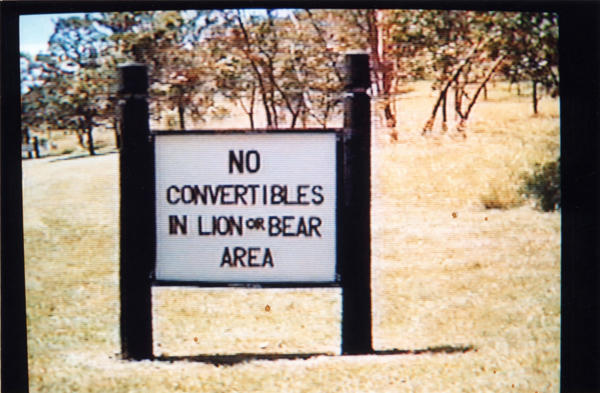
Warning / Vanessa Renwick
DS: Was admiring the Censorship Corrodes icon from Warning (1997), and was wondering if you’ve done much work with public access TV?
VR: I learned video at what was then called Portland Community Access. Also known as PCA. Also known as Porno Christian Access. It is now called Portland Community Media, and it has really open rules. You can put anything on that TV. Some things might need a disclaimer at their head, but anything goes. At least that is how it was when I was there in the mid-90s. I only knew film before that. Film purist I was. I only made a few things at PCM, as I had no equipment of my own, and it was my way to have it. Once I got my own video camera though, I haven't been back.
DS: As you know, I’m an advocate of low power radio, and alternate dissemination modes in general. I saw that NSEW is distributed through Just Seeds,[1] which is very cool. What’s your relationship with them?
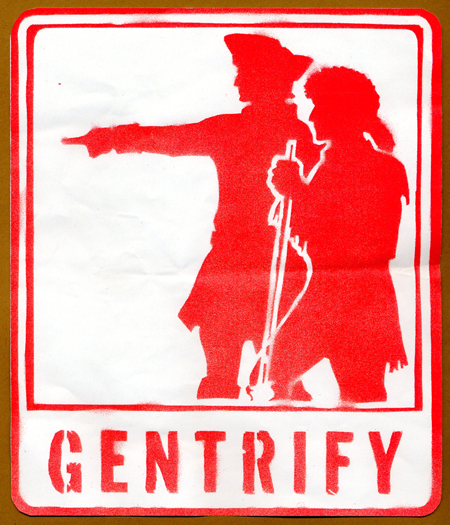
Gentrify / Vanessa Renwick
VR: I have a few really great friends who are collective members of Just Seeds: Alec Dunn, Josh MacPhee and Roger Peet. I once did a collaborative video installation, Rising Up (2004), with their Celebrate People’s History Project posters. I have made a few stencils, and one of them, Gentrify (2008), they included in their books. It is an honor to have them include me on the sidelines. I love that they are able to all work together and get the good word out in such a beautiful manner.
DS: Could you speak about your strategies for getting work into the world? You’ve had a really expanded practice in this regard. What has worked and what hasn’t?
VR: Well, so far, it has been a mix of hitting the road and taking the work to varied venues: the usual route, including institutions, museums, schools, etc, but also grange halls, wolf conferences, punk rock basements, and backyards. There is something great about bringing experimental work to an audience that doesn't have access to it. And not for sit-in-your-room-and-look-at–it-on-your-computer access, but the projected-large-in-a-dark-room-with-others-and-the-maker access. For me to get feedback from the audience is so important. It is really hard though, to book a tour. There are not any experimental film booking agents out there ready to plug you into the calendar. I actually contacted a music booker to see if they would sign me on, but that did not work. It really is a full time job for months ahead of the tour, contacting places and “pinning the calendar on the map,” as Bill Daniel calls it.
I also submit to a few festivals, but not many. That side of me is lacking. There is just so much time to make stuff. As I sit in my studio and answer this question, I think it all works, but when I am out on the road, sometimes I am not thinking that. I admire you so much when I remember how I was bemoaning how few people came to your screening in Portland, but how many (standing room only) came the next day to your lecture. And how you commented that no matter how few people show up to your screenings, that it is always the right amount. And that is true. It always is. Sometimes when there are only two people there, it is the most important screening ever. Just hard to remember that sometimes when it is also your bread and butter and gas money to the next venue. I just made this DVD compilation with 25 shorts and have to get off my ass and out into the world with it. North South East West, here I come.

9 is a secret / Vanessa Renwick
DS: The first film I saw of yours, at least as best I recall, was 9 is a secret. And it just knocked my socks off. It’s got an outstanding, matter-of-fact grace. The way you weave stories of sickness and death and friendship and ravens together. There’s such a deep ethic that comes through. A commitment to laying bare, to being bare, to being present. I remember a walk we took in Iowa City to get some Asian food in a strip mall when you talked about what it’s been like to share this film with people. Could you talk about that a bit?
VR: It is interesting that you say bare. I guess it is. To me it is at the same time blunt, base, and bare, but also existing in some poetic other dimension, which one doesn't really think of usually with things being bare. But maybe that is why it works, it states the other worldy in such bare terms. It almost reads as a fairy tale, too unbelievable to be so bare. I just this year saw Danny Lyon’s Murderers, and he is interviewing one young guy behind bars, asking him why he is in, and when the guy tells him, Danny says, “You murdered a helpless girl. That's horrible.” That honesty coming from Danny just blew me away. One doesn't often come across people so clear and brave in communicating, and especially filmmakers/journalists inserting themselves and their thoughts so clear into their work.
9 is a secret does knock socks off. There are no credits at the end to give people space to think, and extra black and silence at the end to give people space to think. Sometimes audience members will ask me if it is true. There is so much said in it—if what is true? But it is death that they speak of. Or want to know about. We as a culture have shunted death to the corner of the dark closet, and don't often speak of it, unless we are directly dealing with someone who is dying. And then it is a most confusing space to be within. I suggested to my good friend Russ Forster, who made the film So Wrong They’re Right (1999), that he do a zine on hospice and death, as he is now a hospice nurse. And he sees and knows so much that we do not know. I said a zine, as he used to put out the zine 8-Track Mind. But now the idea is blossoming into a book, and I think it will be a much-needed book.
I also have people come up to me privately after screenings to tell me of their experiences. The first time that happened was after the first time I screened it. And it was a revelation to me. Oh yeah, there are others out there like me. Something I would never know, since one never speaks of this. Ever. But as it happened more and more, at other screenings, more and more people privately coming up to me to tell me that they too have been in that same position, I realized how important this film was to be made, and to be shown, a lot.
DS: Oh wow. Great to hear Russ Forster’s name again, and that he become a hospice nurse! My mom used to do hospice nursing, in between stints working at shelters and going to D.C. to lobby for better health care for the homeless. It’s an intense profession. She had to stop after some years because she was getting too depressed from all the death. I knew Russ back in the 8TM days. I actually contributed to some issues, and once helped lead a live radio broadcast 8-track tape repair workshop as part of the expanded Mind actions. I like the idea of instructional radio broadcast because they represent an impossible act of translation. The gap of information is very appealing to me. And funny. One of my students did a great dance instruction piece over the radio for a Lady Gaga song.
VR: That reminds me of when I lived in Knoxville, Tennessee and was listening to the Olympic figure skating competition on the radio. You heard some music, lots of whoosh whoosh whoosh. It was funny. I went and rented a TV the next day to watch the Olympics.
DS: It’s evident in films like House of Sound (2009) or Portland Meadows (2013), that you’re an adroit listener. Having that frank faith in the crazy divergent stories of people’s lives, in what they bring to bear on place, and on history, is what I’ve always loved about Studs Terkel too. A whole social consciousness embedded in listening. Do you go to the races? What brought you to Portland Meadows?
VR: My dad was a contestant on the $64,000 Question in the opera category—that's a whole other story. But he lost a lot of the money that he won on that show at the races. That and My Fair Lady were my only sources of knowledge about horse racing till I was hitchhiking in Oregon in the early-80s and an old man in a station wagon picked me up. Now that I think of it, he wasn't old; I was young. Maybe he was retired. He had cardboard boxes in the back of his wagon filled with index cards with horse racing info handwritten on them. He went around the country betting on horses. That was his thing. He took me to some dinky track in South Eastern Oregon and that was my first horse race. Years later, I went to Portland Meadows a few times. It's only five miles from my house but a whole ‘nother world. 700 horses there. What made the film come about was a lunch film offer from Mike Plante. Sam Green, Mike and I were having dinner last year and talking bout a lot of stuff. When he offered me the Lunchfilm gig, he came up with the idea of the horse track, as I had been talking about horse racing earlier. Which was good. It was one of those subjects that I had flirted with the idea of making something about, but I probably wasn't going to get off my ass and make it.
So, thanks Mike Plante! I made some new friends out there, and having complete access to go anywhere I wanted to was great. The management there was so generous to me, and trusting. There also was a Lunchfilm rule for me about having a minimal soundtrack. I had just been at the Centre Pompidou earlier that year doing a show, and Danny Sasaki was also playing there with the Cascadia Ensemble. He was perfect for the horse track score.
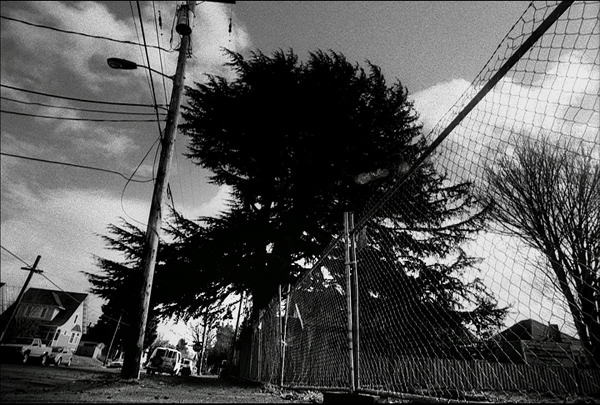 House of Sound / Vanessa Renwick
House of Sound / Vanessa Renwick
DS: Has House of Sound ever been broadcast as a radio piece?
VR: House of Sound… I saved the sign on the closed down record store, and that morning, in my super elated excitement, literally screaming on the street corner, Charles Bedford, one of the people who grew up working there, told me, “You should make a movie about the House of Sound.” And I told him, “There is no movie. The building is getting torn down in two days.” I went home and that night I thought, Charles and all the other guys who owned/worked there, should do a radio show, and play music. So I went back and told him that and it turned into a five-hour radio show. I was on it as well. By the time the radio show was happening, I had also decided to make a video installation about the House of Sound, so that is the first way it existed, a radio show and a video installation. The version I showed in the installation was twice as long as the film, with no soundtrack; instead, there were records that one could play to make their own soundtrack.
The radio show was amazing! I remember while I was in the room with the guys at the station, listening to them talk, and then Wone was sitting there in the corner quietly writing. And every now and then he would read some amazing poem that he had compiled right then from listening to everyone in the room. The poem you hear at the end of the flick, when I heard him recite it, I knew right away it would be the end of my film.
DS: What happened to all those records?
VR: A bunch ended up at Mississippi Records, being sold to the store from people in the neighborhood wanting to make some cash. Still sporting the House of Sound stickers on them. By the time the store closed there were not that many records left, CD’s had taken a foot-hold, and the record renaissance hadn’t started up yet. I assume a lot of them warped, as the building’s roof was shot and a lot of rain got in that beautiful building.
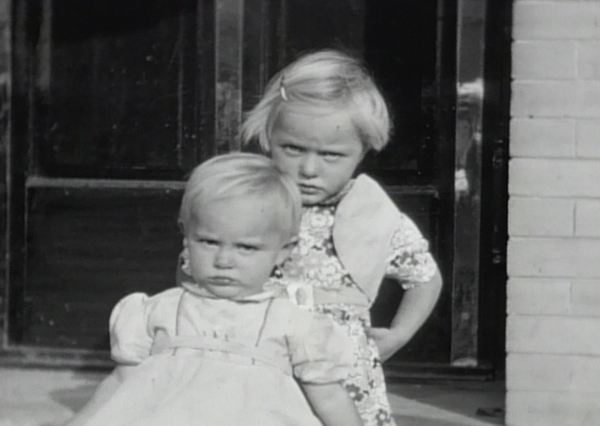 Britton, South Dakota / Vanessa Renwick
Britton, South Dakota / Vanessa Renwick
DS: How did you arrive at the sound for Britton, South Dakota (2003)? It so strongly evokes and furthers the outside-of-time feel. All those unsmiling kids looking into the future from the past...
VR: That was the amazing Johnne Eschleman’s doing. Rick Prelinger had sent Bill Daniel and I some footage to contemplate using in our DeComposer series: two-and-a-half hours of film shot by Ivan Besse in South Dakota during the depression. When I saw the section of it that I use in my film, I immediately knew that Johnee Eschleman was the man to score it. He played live to it, and it floored me. I then arranged for him to get in a studio to play it again, so that others could see it as well with his score. Keyboards and two LP’s. One of whale noises and one of thunderstorms. Both slowed down.
DS: I really like seeing the section in Hope and Prey (2006) with the small negative-white birds across all three monitors—how they form a kind of slow tidal undulation. It’s beautiful. And that long sequence with one raven chasing another. What’s up with swifts and geese in 35mm? Do you have an approach for shooting in mind already?
VR: Shooting the swifts right now! Tonight! Full Harvest Moon! Also shot last week some. 35mm got thrown out the window due to financial constraints. Geese will come next week or so. This is all for a new solo show on birds that I am doing in the spring at The Art Gym at Marylhurst University. Sam Coomes will be doing the score. He did the sublime Trojan (2006) score, and the tripped out FULL ON LOG JAM (2010) score as well. I just revisited that and loved that he put flies in the soundtrack. And he is an avid birder.
Those birds in Hope and Prey: Crows I shot one and a half blocks away from my house. The raven chasing sequence, Bob Landis’ genius! Always takes my breath away and calms me down while watching that long shot. It is as if Bob is flying with the birds with his camera work. At one with them. The swifts, they are hard to shoot... soooo tiny and so fast! My approach? It is all about the upward gaze, while lying down. It will be geometry and science and sky and patterns taking you elsewhere. That is the plan anyways, surrounded by giant colorful birds pierced by light ringing you as you lie down and gaze up. I often find myself looking upwards, even indoors. Frequently people I am talking with, hanging out with, turn around to look up behind them to see what I am looking at, as I gaze above and beyond them. What do they see? If out of doors, most likely sky and clouds and birds and tree tops. If indoors, it’s usually a wall hitting a ceiling. Fascinating stuff. I like to see where things come together and fall apart. And how light falls on it all. Maybe I like looking upwards as it is more of a BILD FREI, as the Germans say to clear the set for a shoot. Literally “Picture Free.” Less clutter in the upmost corners. More expanse to bring me elsewhere. Away isn't a place, it’s a feeling.
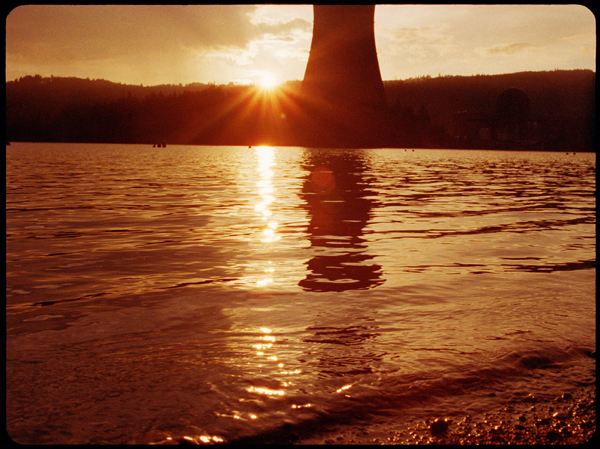
Trojan / Vanessa Renwick
DS: Tell me some things about plumbing.
VR: Andre the Polish plumber has hella booze breath at 8 a.m., but can get the shit done.
NOTES
1. Just Seeds Artists’ Cooperative makes, disseminates and archives an incredible array of contemporary and historic socio-political print and design work.
Published November 4, 2013
ABOUT THE AUTHOR
Deborah Stratman is a Chicago-based artist and filmmaker interested in landscapes and systems. She has exhibited internationally at venues including the Whitney Biennial, MoMA NY, the Pompidou, Hammer Museum, Witte de With, Walker Art Center, Yerba Buena Center, and has done site-specific projects with the Center for Land Use Interpretation, Temporary Services, Mercer Union (Toronto), Blaffer Gallery (Houston), Klondike Institute of Art & Culture (Yukon) and Ballroom Gallery (Marfa). Stratman’s films have been featured at numerous international festivals including Sundance, the Viennale, Full Frame, Ann Arbor, Oberhausen and Rotterdam. She is the recipient of Fulbright and Guggenheim fellowships, a Creative Capital award, and she currently teaches at the University of Illinois at Chicago.
